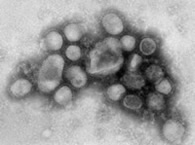News Release: Research, School of Medicine, Woodruff Health Sciences
May 5, 2009
H1N1 Research Includes Monoclonal Antibodies, Virus-Like Particles, Virus Transmission Studies
Emory/UGA Flu Center Is One of Six Centers Leading National H1N1 (Swine Flu) Research Response
 H1N1 Influenza virus, image from CDC
H1N1 Influenza virus, image from CDCIn a multi-pronged attack against the H1N1 virus, researchers at Emory University are using a new method of rapidly producing highly targeted monoclonal antibodies to develop a diagnostic test as well as a temporary therapy to stave off the H1N1 (swine flu) virus. The antibodies, which can be isolated from a small amount of the blood of humans infected with the virus, could be targeted against H1N1 and rapidly reproduced to detect or attack the virus. The monoclonal antibody technology was described last April in the journal Nature and is being developed in collaboration with scientists at the University of Chicago.
In addition, Emory scientists, along with colleagues at the Centers for Disease Control and Prevention (CDC), are using virus-like particles (VLPs) to develop a quicker, more efficient alternative to the current method of making flu vaccine by growing it in chicken eggs. VLPs are empty shells that look like viruses but don't reproduce. In March, the scientists described the effectiveness of their VLP vaccine in mice in the journal PLoS (Public Library of Science) One.
An Emory-University of Georgia Influenza Pathogenesis and Immunology Research Center (IPIRC) is a key component in a national scientific effort to address the H1N1 (swine flu) outbreak. The intensive U.S. research initiative, led by the National Institutes of Health (NIH) and the Centers for Disease Control and Prevention (CDC), is centered in six national NIH Centers of Excellence for Influenza Research and Surveillance, including the one led by Emory University and UGA.
"Emory has one of the world's leading groups of infectious disease experts, vaccine scientists, immunologists and microbiologists," says David S. Stephens, MD, vice president for research in Emory's Woodruff Health Sciences Center. "Our research and groundbreaking discoveries by scientists at the Emory Vaccine Center, the Yerkes National Primate Research Center, Emory University School of Medicine and collaborators at the University of Georgia provide a strong basis for our contribution to this coordinated national effort against H1N1."
Emory scientists in the flu research center are conducting several key projects as part of the national research effort. These include determining how the H1N1 virus enters cells, is transmitted, and how that process might be interrupted; finding out whether prior exposure to other influenza viruses may help or hinder immune responses to the new virus; assessing possible pre-existing immunity to H1N1 in different age groups; analyzing the recovery of infected patients; developing a method to quickly make monoclonal antibodies targeted to the H1N1 virus; and beginning the initial stages of a new vaccine.
At the University of Georgia, scientists are studying how the H1N1 virus is transmitted between animals; finding out how the virus infects human airway cells; developing diagnostic tests to distinguish different virus strains; evaluating the stability of the virus; and testing vaccines and anti-viral drugs against the virus.
"Our scientific team is proud to be contributing to the public good as one of the six influenza research centers in the U.S.," says Richard Compans, PhD, director of the Emory-UGA center. "The pairing of Emory's expertise with strengths at UGA in animal pathology creates a uniquely effective combination for studying crossover viruses such as 'swine flu.' We expect to make significant contributions to this national research effort."
The Emory-UGA IPIRC, along with the five other national flu centers, was established in April 2007 with a seven-year, $32.8 million contract from the NIH.
In the event of a public health emergency involving the emergence and spread of an influenza pandemic in humans, the network of centers is directed to "be on the frontline" to implement the NIAID Pandemic Public Health Research Response Plan.
For more information:
- Emory-UGA Influenza Pathogenesis and Immunology Research Center
- NIH Centers of Excellence for Influenza Research and Surveillance
- NIH Awards Emory $32.8 Million to Create Influenza Center of Excellence (Press Release, 4/2/07)
- Method for Fast Human Antibodies Against Flu Could Find Broad Use (Press Release, 4/30/08)
- Novel Pandemic Flu Vaccine Effective Against H5N1 in Mice (Press Release, 4/2/09)
###
The Robert W. Woodruff Health Sciences Center of Emory University is an academic health science and service center focused on missions of teaching, research, health care and public service. Its components include schools of medicine, nursing, and public health; Yerkes National Primate Research Center; the Emory Winship Cancer Institute; and Emory Healthcare, the largest, most comprehensive health system in Georgia. The Woodruff Health Sciences Center has a $2.3 billion budget, 17,000 employees, 2,300 full-time and 1,900 affiliated faculty, 4,300 students and trainees, and a $4.9 billion economic impact on metro Atlanta.
Learn more about Emory’s health sciences:
Blog: http://emoryhealthblog.com
Twitter: @emoryhealthsci
Web: http://emoryhealthsciences.org
